087 – Counselling Self Harm Clients
Counselling Tutor
Ken Kelly and Rory Lees-Oakes
4.6 • 636 Ratings
🗓️ 22 September 2018
⏱️ 42 minutes
🧾️ Download transcript
Summary
Transcript
Click on a timestamp to play from that location
| 0:00.0 | Welcome to the Counseling Tutor Podcast. |
| 0:04.4 | The must listen to podcast for students of counselling and psychotherapy. |
| 0:10.6 | Here are your hosts, Rory Lee's Oaks and Ken Kelly. |
| 0:15.8 | Hello and welcome to the counselling tutor podcast with me, Rory Lee's Oaks. |
| 0:20.3 | And with you as always, |
| 0:21.4 | the countertransference to my transference, Mr. Ken Kelly, how are you doing today? I'm exceptionally |
| 0:27.0 | well. Thank you very much for asking, Rory. How do you find yourself today? I find myself wet. |
| 0:32.5 | I've just been outside and it's counseling towers is absolutely immersed in water. It's raining, |
| 0:38.4 | raining, raining. Like it. Well, we is absolutely immersed in water. It's raining, raining, raining. |
| 0:39.7 | Like it. |
| 0:42.6 | Well, we don't have a wet episode today. |
| 0:44.9 | In fact, we have an important episode. |
| 0:50.2 | And I think maybe an episode that I would like to ask right at the top of this episode that you might share with your peers, students on counselling courses, but not just that |
| 0:55.8 | actually practicing counselors. It's important topics that we're covering today, specifically the |
| 1:01.2 | first topic that we're going to be opening with, and that is self-harm. This has been in the news |
| 1:06.0 | quite a lot recently. There is definitely a rise in the reporting or the identification of self-harm |
| 1:13.2 | and Rory and I are going to be speaking about that and giving you some really good links to |
| 1:18.5 | some further training, research and reading that you can do. Going into practice matters, |
| 1:24.4 | now this is an exciting one because I'm reading from my clipboard |
| 1:27.8 | and today practice matters. Now practice matters is basically where we take important stuff |
| 1:33.0 | that links into the practice when we're actually in with the client. We're going to be talking |
| 1:37.2 | about shrinking people. So I have this picture in my mind, Rory, of you wheeling in the shrinking |
... |
Please login to see the full transcript.
Disclaimer: The podcast and artwork embedded on this page are from Ken Kelly and Rory Lees-Oakes, and are the property of its owner and not affiliated with or endorsed by Tapesearch.
Generated transcripts are the property of Ken Kelly and Rory Lees-Oakes and are distributed freely under the Fair Use doctrine. Transcripts generated by Tapesearch are not guaranteed to be accurate.
Copyright © Tapesearch 2025.

